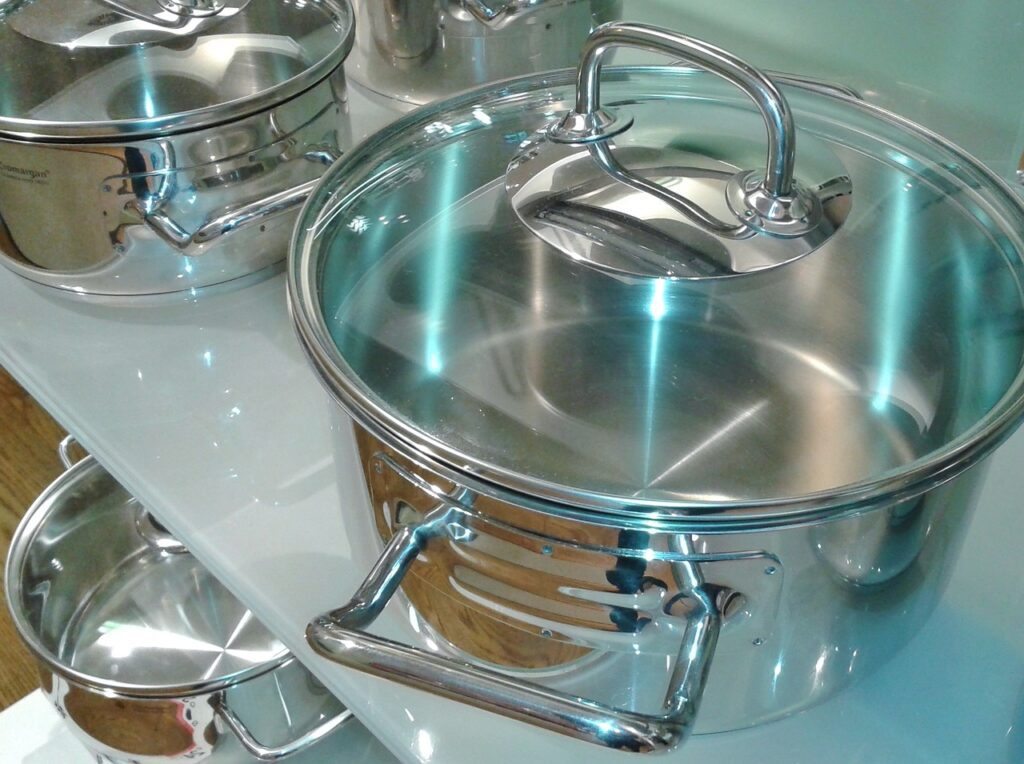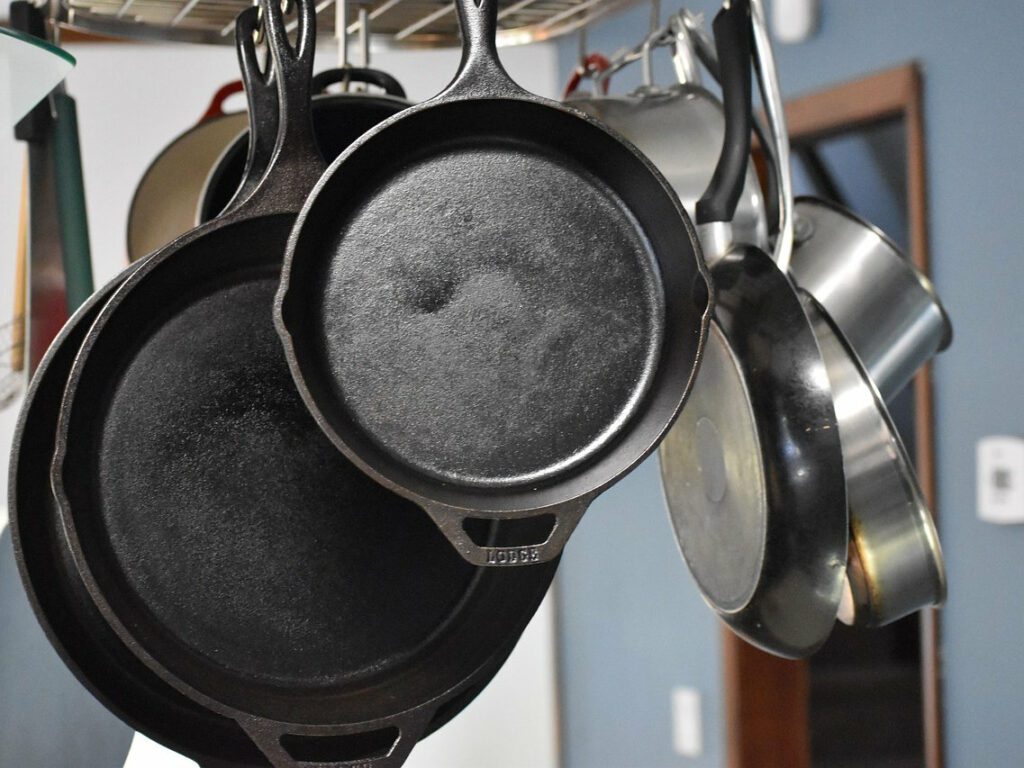Unveiling the Best Cookware Brands and Types for Your Culinary Adventures
Introduction: Navigating the World of Cookware
Cooking enthusiasts understand the pivotal role that cookware plays in achieving delectable results. With an array of options available, ranging from cast-iron, stainless steel and coated non stick pots, selecting the right cookware can be a daunting task. Fear not! This guide is your roadmap to deciphering the world of cookware.
Seasoned Cast Iron Skillet: Much Loved
If you’re a budding chef exploring the culinary world, diving into the myriad of kitchen tools can be overwhelming. Yet, there’s one classic piece that has withstood the test of time, transitioning seamlessly through generations: the seasoned cast iron skillet. Here’s why this vintage darling deserves a prime spot in your kitchen.
Unrivaled Heat Retention: One of the standout features of a cast iron skillet is its impressive ability to retain heat. As you embark on your cooking journey, you’ll find that even heat is crucial for many dishes. Transitioning from a gentle simmer to a roaring sear becomes a walk in the park with this skillet in hand.
Versatility at Its Best: From stove to oven, and from frying to baking, a cast iron skillet adapts with ease. Imagine crafting a delectable sautéed dish on your stove and then transitioning it directly into the oven for a perfect finish. This skillet offers that flexibility, making multitasking in the kitchen a breeze.
Natural Non-Stick: Over time, as your skillet becomes well-seasoned, it evolves into a naturally non-stick surface. This means less reliance on artificial non-stick sprays and an enhanced flavor profile for your dishes. Moreover, it’s a healthier choice, cutting down on additional fats and oils.
A Lifetime Companion: Another compelling benefit is the sheer durability of cast iron skillets. With minimal care, they can last for generations. So, as you refine your culinary skills, your skillet will be right there with you, maturing and improving with every dish you craft.
Budget-Friendly: Despite its array of benefits, a cast iron skillet won’t burn a hole in your pocket. It’s an affordable piece, proving that you don’t need to splurge to secure quality in the kitchen.
Eco-Friendly Choice: In an era where sustainability is key, this skillet shines. Its longevity means less waste, and its natural non-stick quality reduces the need for chemical-laden alternatives.
To conclude, a seasoned cast iron skillet isn’t just a cookware piece; it’s an heirloom, a culinary partner, and an eco-friendly choice. As you venture into the art of cooking, having this skillet by your side will undoubtedly enhance your culinary endeavors. So, if you’re looking to invest in a kitchen essential that promises durability, versatility, and impeccable performance, the seasoned cast iron skillet is a match made in culinary heaven.
Should You buy Stainless Steel Cookware? Unraveling Culinary Excellence
Stainless steel cookware has long held a prime spot in kitchens around the world, and for good reason. Its undeniable blend of aesthetics, durability, and cooking performance makes it a favorite amongst both novice home cooks and professional chefs. But is it the right choice for your culinary needs? Let’s delve into the strengths and considerations of stainless steel, and help you determine if it’s the gleaming set you should be reaching for the next time you’re whipping up a culinary masterpiece.
Beauty Meets Functionality One of the most evident perks of stainless steel is its polished, sleek appearance. These pots and pans can easily enhance the aesthetics of any kitchen. But stainless steel isn’t just about looks. Its smooth, non-reactive surface means that you can cook any type of food, even acidic dishes like tomato sauce, without worrying about metal leaching into your meals.
Durability That Lasts When we talk about a long-term investment for your kitchen, stainless steel cookware often tops the list. Resistant to chipping, staining, and rusting, these utensils are built to last, ensuring you won’t be returning to the store for replacements anytime soon. Moreover, they can withstand high heat, making them perfect for searing, browning, and deglazing.
Uniform Cooking Many stainless steel pans come with an aluminum or copper core. This is a game-changer. Why? Because it allows for even heat distribution, preventing those frustrating hot spots that can unevenly cook your food or cause it to stick to the pan.
Maintenance and Care Stainless steel might require a little more care than non-stick pans, but the results are worth the effort. Maintaining its shine might require occasional polishing, and deglazing the pan can help release browned bits of food, which are not only easy to clean up but also perfect for making sauces.
Compatibility and Versatility Transitioning from stovetop to oven? No problem! Stainless steel cookware is typically oven-safe, allowing you versatility in your cooking techniques. Plus, if you have an induction cooktop, many stainless steel sets are compatible, making them a versatile addition to diverse kitchen setups.
Points to Ponder Of course, no cookware is without its considerations. Stainless steel does have a learning curve, especially if you’re transitioning from non-stick. Foods might stick if the pan isn’t properly preheated or if too little oil is used. However, once you’ve mastered the nuances, cooking with stainless steel can be a delightful experience.
Thoughts for the Novice Chef If you’re just starting on your culinary journey, investing in stainless steel cookware might seem like a leap. But remember, cooking is an art, and every artist deserves the best tools. Stainless steel offers a blend of beauty, durability, and performance that not only makes cooking efficient but also elevates it to a higher form of pleasure. As you grow and evolve in your cooking skills, you’ll appreciate the resilience and versatility this cookware brings to your kitchen.
In the end, whether or not you choose stainless steel comes down to your personal needs and preferences. But if you’re looking for a cookware set that combines aesthetics with exceptional functionality, and you’re willing to climb that learning curve, stainless steel might just be your kitchen’s new best friend.


Coated Non-Stick Cookware: A Closer Look
Navigating the world of cookware can be overwhelming, especially with the myriad of options available. Among these, coated non-stick cookware has made significant ripples, offering promises of easy cooking and even easier cleaning. But is it the right fit for your kitchen? Let’s dissect the advantages and concerns surrounding non-stick pans to help you make an informed decision.
Advantages of Coated Non-Stick Cookware:
- Easy to Use: Even for the most novice chefs, non-stick pans make cooking more manageable. Food releases effortlessly, making flipping and stirring a breeze.
- Less Oil Required: Health enthusiasts often lean towards non-stick pans as they require less oil or butter, allowing for a reduction in overall fat and calories in meals.
- Simple Cleanup: Say goodbye to aggressive scrubbing. Food residues slide right off, ensuring a swift and straightforward cleaning process.
- Uniform Cooking: Non-stick pans often provide even heat distribution, ensuring consistent cooking results.
Concerns to Consider:
- Durability: While advancements have been made, coated non-stick pans might not last as long as stainless steel or cast iron counterparts. Over time, the coating can wear off, especially if used with metal utensils or cleaned with abrasive materials.
- Health and Environmental Concerns: Older non-stick coatings were made with PFOA, a chemical linked to health concerns. Though many manufacturers have phased out its use, it’s crucial to research and choose pans labeled PFOA-free.
- Not Ideal for High-Heat Cooking: Non-stick pans aren’t always suitable for high-heat cooking methods like searing, as excessive heat can damage the coating. Moreover, when overheated, some non-stick coatings can release fumes potentially harmful to pets, especially birds.
- Oven Limitations: While some non-stick pans are oven-safe, they often have a lower heat threshold compared to other cookware types.
Points to Ponder:
When considering non-stick cookware, reflect on your cooking style. If you frequently sear meats or aim for those crispy edges on foods, non-stick might not be the best choice. However, if you’re into low to medium heat cooking like making pancakes, omelets, or gently sautéing vegetables, non-stick pans could be a valuable asset.
Also, the care you’re willing to provide is crucial. Non-stick requires gentle cleaning and protection from scratches, so if you’re not up for that commitment, you might want to look elsewhere.
To Buy or Not to Buy?
In conclusion, coated non-stick cookware presents both advantages and concerns. For those just starting in the kitchen or those prioritizing ease and convenience, these pans can be an excellent choice. However, with concerns about durability and health implications, it’s essential to invest in high-quality non-stick cookware from reputable brands, ensuring longevity and safety. Like any culinary tool, the key is informed choice and proper care.
You need to ask yourself
1. Budget Bliss: How Much Can You Invest? Before embarking on your cookware journey, establish a budget that aligns with your culinary aspirations. Remember, quality cookware is an investment that pays off with every sumptuous meal.
2. Dishwasher Dilemma: Convenience vs. Hand Care Consider your stance on dishwasher compatibility. While some cookware can brave the machine, others require gentle hand care. Choose a path that complements your lifestyle.
3. Nonstick or Uncoated: The Sizzle Factor Define your culinary preferences. Do you yearn for the sizzle of browning on uncoated surfaces, or does the allure of eggs sliding off a nonstick pan captivate you? Tailor your choice to match your cooking desires.
4. Culinary Excellence or Cleanup Ease? Strike a balance between culinary prowess and ease of cleanup. Assess whether you prioritize top-notch cookware or minimal post-cooking scrubbing.
Conclusion: Cookware Crafted for Your Culinary Identity
In the dynamic world of cookware, choosing between coated non-stick, cast iron, and stainless steel pots can be a culinary conundrum. Each offers unique benefits tailored to specific cooking styles and preferences.
Coated non-stick pots excel in convenience and health-conscious cooking with less oil, but they demand gentle care for longevity.
Cast iron, with its impeccable heat retention and naturally enhancing seasoning, brings rustic charm and durability to the kitchen but requires routine maintenance to prevent rust. Stainless steel, on the other hand, offers a robust and non-reactive cooking surface perfect for a range of dishes, though it might lack the non-stick ease of other options.
In essence, your ideal pot hinges on your culinary priorities, be it ease, durability, or versatility, ensuring every meal is a masterpiece in the making.
